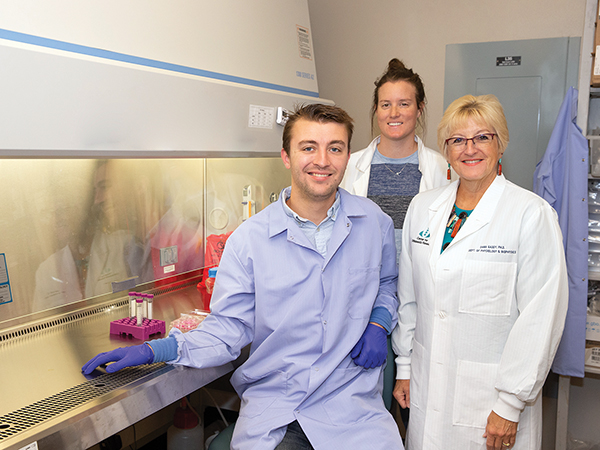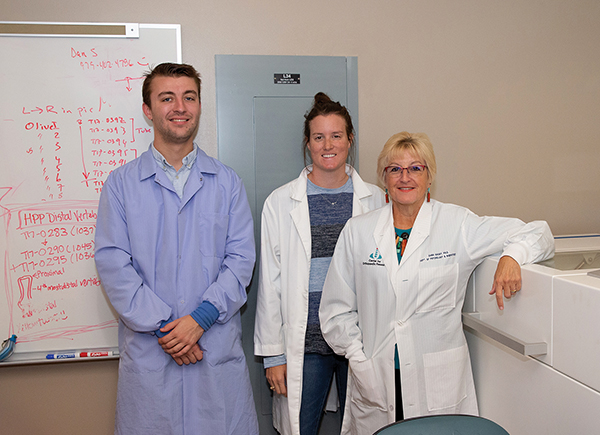Finding Meaning In Mentorship
Story by Jennifer Gauntt, CVMBS Communications
Dr. Dana Gaddy has been blessed with the support of many, so now she’s paying it forward by using the lessons she’s learned to build relationships with her own students.

Dr. Dana Gaddy’s mentor Joanne Richards once told her, “People are like plants. You just need to give them a bit of water and let them grow.”
That philosophy is so deeply rooted into Gaddy that she tears up when she speaks of her relationship with Richards and what mentorship now means to her as a professor in Texas A&M College of Veterinary Medicine & Biomedical Sciences’ (CVM) Department of Veterinary Integrative Biosciences (VIBS).
“Every single person Jo mentored feels that she played a key role in their having a fulfilled life,” Gaddy said, catching herself as her voice softly begins to break. “Just because you have 50 graduate students and postdocs does not mean that you have 50 happy, fulfilled graduate students and postdocs. What was important to her was to build 50 relationships. That’s what it’s about.”
And, indeed, that has been what it’s about for Gaddy; mentorship, she believes, is for life.
Planting The Seeds
She’s been blessed with many mentors throughout her life, starting during her time as a Ph.D. student at Baylor College of Medicine, where Richards was her adviser.
“I was always mystified by her ability to take students who would come into her lab as postdoctoral fellows but really were not on the same wavelength as the rest of the folks and by working elbow-to-elbow with them and through regular conversations, she would figure out what made them tick,” Gaddy said. “Then, she would place opportunities in front of them—some of which were not academic—that would put them in the direction where they’re going to be happiest. She didn’t just mold them after herself.”
This was modeled by another set of influential mentors, Drs. Gideon and Sevgi Rodan.
“I met Gideon when I was a brand-new faculty member and was doing stuff that was really kind of heretical to the bone field at the time,” Gaddy said. (She focused on the importance of the reproductive hormone inhibin in menopause, when the scientific consensus placed the sole significance on estrogen.)
“He and his wife, Sevgi, were like the mom and pop,” she said. “They always did things for their mentees, even those who went off to other companies or would go back to academia. People who left would always come back, and the Rodans kept track of them.”
Her relationship with the Rodans made it particularly poignant when this fall Gaddy received the Gideon A. Rodan Award for Mentorship from the American Society for Bone and Mineral Research (ASBMR).
“He took lots of people under his wing, even those who didn’t have anything to do with Merck,” Gaddy said. “He would mentor everyone who seemed to want to listen to what he had to say, and his words of wisdom were usually spot on.
“That scientific progeny concept is one that I was steeped in as a young faculty member, as a young scientist, as a graduate student, and it stayed with me,” she said.

A Winning Combination
Gaddy sees herself as a “different kind of mentor,” in part because her mentee pool has been much smaller than previous Rodan Award winners—who have 10-20 trainees at any given time, compared to the three typically working in Gaddy’s lab—but also because she comprehensively evaluates her students and their potential, understanding that what is best for the student may not be best for her.
“Part of it is paying attention and trying to read people like my Ph.D. adviser did, to try to understand what it is that really is making them tick,” Gaddy said. “If I give them something to do and they hate it or they love something else, I see it as my responsibility to figure out how I can provide them more of that so that then they see the success, they feel the success, and they want to go do more in that direction.”
It’s also included helping students evaluate what their end-goals are earlier in their academic career and encouraging them to pay attention to what’s happening in all job sectors before they start a dissertation and it becomes too late to change their minds.
“Many graduate students coming into my lab initially think that they are going to do what I do, but that ends up not really being their path,” Gaddy said. “My job is to help them find whatever the path is and then help them find a way to get there.”
As a result, some of her graduate students have moved into other CVM faculty members’ labs; in other cases, she has “adopted” trainees working in colleagues’ labs.
She estimates that she is probably actively mentoring six former students, one current doctoral student, and a handful that are affiliated with other CVM laboratories; it is that idea of connecting people across areas, whether it’s for mentorships or just networking, that is important for Gaddy.
“I have done more of that for other people’s students than I have for my own, not even people at my institution,” she said. “I’ve been involved in the Endocrine Society and the Women in Endocrine Society, as well as the Bone Society and other groups, for which we’ve done professional development events about how to choose a mentor, how to set that mentoring conversation and relationship up, and then what to do if it doesn’t go well, or how to launch out of somebody’s lab to gain independence.”
While the connections she’s made, and the award she’s won, have been rewarding, the ultimate reward, in her eyes, is seeing her students succeed in advancing science in their own ways. Among her mentees, Joshua Bertles is her current Ph.D. student in the biomedical sciences graduate program; Kristy Nicks, Ph.D., is a program director at the National Institutes of Health’s National Institute of Arthritis and Musculoskeletal and Skin Diseases; Tristan Fowler, Ph.D., is a research scientist director at the biotech company Surrozen; and Daniel Perrien, Ph.D., is an associate professor at Emory University.
“That’s what I’m most proud of, because you never know what that student is going to want to do when they first walk in your door,” she said. “I try to spend time programmatically identifying or at least providing exposure to opportunities that will help them learn what it is that floats their boat. And when they find that, there’s no better reward.”
###
Note: This story originally appeared in the Spring 2020 edition of CVM Today.
For more information about the Texas A&M College of Veterinary Medicine & Biomedical Sciences, please visit our website at vetmed.tamu.edu or join us on Facebook, Instagram, and Twitter.
Contact Information: Jennifer Gauntt, Director of Communications, Texas A&M College of Veterinary Medicine & Biomedical Sciences; jgauntt@cvm.tamu.edu; 979-862-4216


